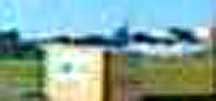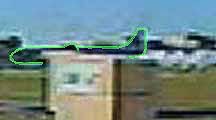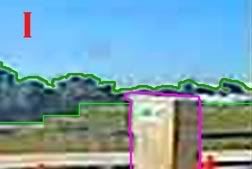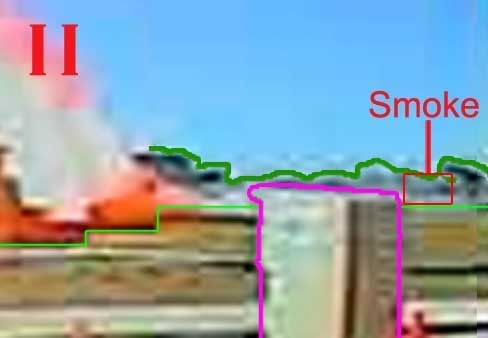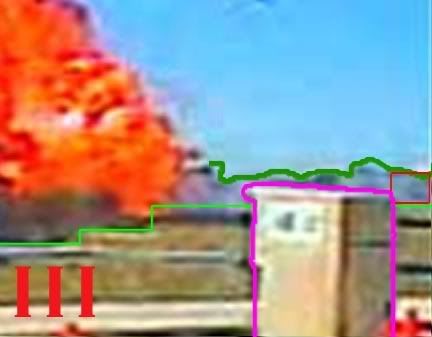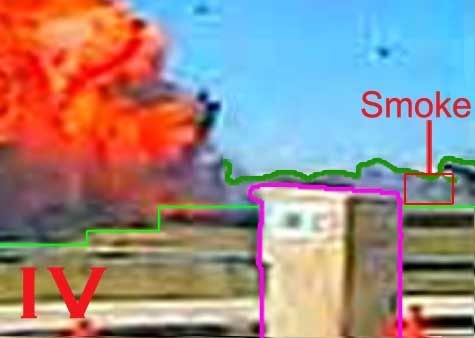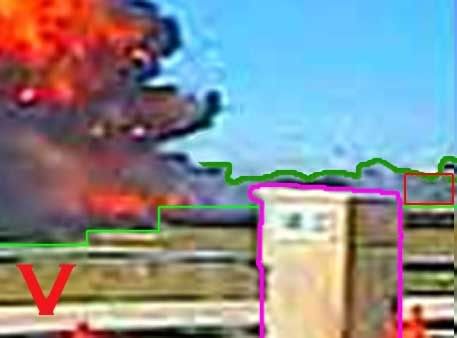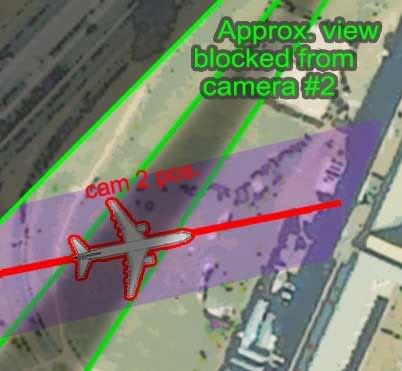And an analysis of "Zebra's" alleged missing frames
last updated 3/6/07
I've been looking at the two Pentagon CCTV security cameras that captured the "white blur" crossing the West lawn before exploding into the building. Both videos show a portion of the blur in exactly one frame, and the next is the explosion. Here I attempt to break down how this lines up with the camera's frame rate. For simplicity, we are here going to ignore possibilities like different craft or speed range, different distance from the camera or approach angle, and the possibility of manipulated footage. Those all open an infinite number of variables that makes it impossible to verify anything.
First, Flight 77's speed: reports vary but include:
FEMA: 532 mph
ASCE: 479 mph
9/11 Comm: 530
Russell Pickering: more than 400
Flight Data Recorder, NTSB study: about 550-575 mph
others have cited figures like "at least 250" and "at least 300 mph." The high end speeds would seem less likely, as the higher the speed the harder the handling at extremely low altitudes. Yet the Flight data recorder shows a final rate pushing the plane’s top speed of about 600 mph. So I settled on a range of sample speeds; 350mph (0.097 mps), 420mph (0.117 mps), 460mph (0.1333 mps), 530mph (0.1472 mps), 575 (0.159 mps).
The American Society of Civil Engineers (ASCE), in their 2002 Pentagon Building Performance Report, calculated the distance to the building from nosecone in the 2002 stills (camera two) as 320 feet. My same distance based on my camera field of view analysis and generally accepted flight path is 350 feet. Close enough, I’ll go with their numbers for now.
Time needed to cover remaining distance to the building (320 feet / 0.05 miles):
@ 350mph = 0.58 sec
@ 420mph = 0.48 sec
@ 480mph = 0.42 sec
@ 530mph = 0.38 sec
@ 575mph = 0.31 sec
So I can only offer a liberal range of times needed to cross that last distance, from 0.31-0.58 seconds, give or take for exact distance, all well under the one-second frame rate. From Camera one’s view, the plane is further back - the frames captured by it seem to have been a split-second ahead and caught the nosecone just crossing the threshold of peripheral vision – distance to building then, by my estimates, is about 450 feet (.08 miles), increasing the time needed to cross – then the span is more like .5 to .8 seconds – nearing the frame rate expectation of a second glimpse, but still falling short.
 Left: camera two. Right: camera one. (click to enlarge)
Left: camera two. Right: camera one. (click to enlarge)Presuming neither video is missing any frames, this gives us 0.4-0.6 seconds for the impact fireball to erupt before the next frame was taken by camera two. With camera one we have about 0.2-0.5 seconds for the same phenomenon, explaining the overelming brightness of the younger burst recorded there. In short, at that frame rate and those speeds, we should expect exactly one frame of the plane from each camera’s view, no more and no less.
 The explosion: what's the time lag in these corresponding frames?
The explosion: what's the time lag in these corresponding frames? Now to the analysis presented by a fellow member at Above Top Secret (screen name“Zebra”) whose well made website alleges that one frame is missing from each camera’s record just as the plane enters. Seeing the plane nosing into cam 1 and fully present in cam 2, he saw two different frames and wondered why there weren’t corresponding frames for the nosing-in phase on cam 2 or the fully-present phase in cam 1. After the analysis above, it’s clear however that if such frames did exist and were excised, this means the plane flew about 130-feet between the frames, given the ASCE’s numbers, which roughly jive with my own.
At one second apart, that gives it a speed of 72 mph between the two stages. To cover the remaining distance from the fully-present stage to the building’s wall (320 feet) at that rate would take it three seconds, necessitating another three frames missing from each camera’s record. In fact, I'm pretty sure airliners stop flying altogether when they get down to 72 mph.
So what else could account for the positional difference in the two frames we’ve seen? As Zebra summed up the possibilities, “either the speed of the flying object is tremendous or another incident with the camera generated a frame totally out of synchronization or those two frames are in fact 1 second apart and have each a corresponding frame missing in the other video.” My money’s going on the speed one. At even the slowest sample speed of 350 mph, that 130 foot difference would be covered in .2 seconds, and the higher speeds would in fact lessen the time difference needed. So 0.2 is the high end. and Zebra himself admits a delay of "no more than 0.1 second" (I'm not sure where he got this exact difference). At any rate, a difference of .2 seconds falls closer to the small time lag between the two cameras than it does to the frame interval within either camera. Judging from the differences in other correlary frames compared to frame-frame differences within a camera, I'd guess the time lage between them at noticeable but well under 0.5 seconds - anywhere from 0.1 to 0.3 and a perfect fit for the differences in the white blur frames.
Updates: Now here's where I went wrong the first time. The frames before the plane, as Zebra lays them out, seem to line up with a slight delay, camera one ahead. After the plane, they line up about the same, even with the three blank spaces inserted. (except at row 27, frames 0864 and 2719, where camera two seems to be slightly ahead judging by the projectiles at the top, though this is probably a trick of perspective I can't explain right now). Anyway, the point is even if we ignore the two "missing" frames that give the plane a ridiculous speed and that cancel each other out, one camera must be missing a frame for these to line up both before and after.
But I'm also seeing other problems with the anlysis I'd glossed over before. Zebra's identification of the plane is off, in my opinion. In cam 2, he sees nosecone, right wing and right engine. At almost no angle but near-head on would we be ale to see even the tip of the right wing out ahead of the nosecone. They are set too far back for that. and in cam 2, he's been tricked by the dark tailfin, seeing the same white that was just plane now as smoke behind it, and seeing the plane itself suddenly black. This makes the possibility of the frames being off seem more likely, giving us a greater positional difference of about 475 as compared to 105, giving us a semi-plausible speed of 320 mph. But this is still far slower than most reported speeds, and of course relies on that baing the tailfin, which I'm pretty sure it isn't.
